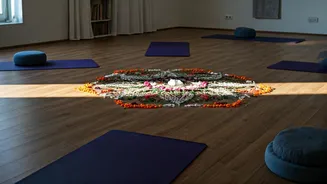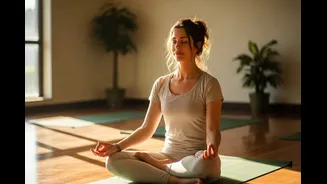Introduction to Yoga
Yoga, an ancient practice originating in India, combines physical postures, breathing techniques, and meditation to unite the mind, body, and spirit. It
has evolved over thousands of years, with various styles and approaches developed. Hatha yoga forms the basis of many modern practices, focusing on postures (asanas) and breathing exercises (pranayama). Beyond its physical benefits like increased flexibility and strength, yoga is increasingly recognized for its cognitive enhancements. Studies highlight its effectiveness in reducing stress, improving focus, and boosting memory. These benefits stem from yoga's ability to regulate the nervous system and increase blood flow to the brain. By incorporating simple yoga poses into your routine, one can potentially improve overall mental performance and clarity. This article explores specific 10-minute yoga poses and their effect on memory and focus.
Mountain Pose (Tadasana)
Tadasana, or Mountain Pose, forms the cornerstone of many yoga practices and is a simple yet powerful starting point for improved focus. To perform Tadasana, one must stand tall with feet hip-width apart, distributing weight evenly. Engage your core, keeping the spine straight but not stiff, and relax the shoulders, allowing the arms to hang naturally at the sides. Direct your gaze forward, towards a fixed point, which helps develop concentration. The steady stance and awareness of the body in Tadasana cultivate a sense of groundedness, which can reduce mental clutter and enhance focus. Holding the pose for a minute, while focusing on the breath, provides a foundation for mental stillness. Tadasana's benefits extend to improving posture and body awareness, which contributes to a more integrated mind-body connection, and, subsequently, better cognitive function. Daily practice of Tadasana can help to establish a mental reset, making it an excellent warm-up exercise for other yoga postures, or as a standalone activity to boost focus during a busy day.
Tree Pose (Vrksasana)
Vrksasana, or Tree Pose, challenges balance while also enhancing mental focus and concentration. To begin, shift your weight onto one leg, bending the other knee. Place the sole of the raised foot either on the inner thigh or calf of the standing leg, avoiding the knee. Once the pose is established, bring the palms together in a prayer position at the chest, or raise them overhead. Maintain a steady gaze on a fixed point, known as a drishti, to aid in balance. The act of balancing on one leg requires the brain to actively coordinate muscles and maintain stability. This process strengthens neural pathways, improving both physical and mental balance. Holding Vrksasana for approximately one minute, while focusing on the breath and the fixed point, can calm the mind and significantly boost focus. Regular practice of Vrksasana promotes a sense of calm amidst chaos, improving decision-making ability and enhancing overall cognitive performance, making it a valuable exercise to incorporate into your day.
Triangle Pose (Trikonasana)
Trikonasana, or Triangle Pose, not only increases flexibility and stretches the body, but also helps to improve focus. To perform this pose, stand with feet wide apart, approximately one leg's length, with one foot turned outwards at a 90-degree angle and the other foot turned slightly inwards. Extend both arms to the sides, parallel to the ground. Then, bend at the hip, reaching the hand towards the front foot while the other hand reaches upwards. The gaze should be directed towards the raised hand. The precise movements and awareness of the body's alignment required in Trikonasana sharpen mental focus. The pose demands a steady gaze, or drishti, which is essential for maintaining balance and concentration. Additionally, the deep breathing encouraged during the pose helps reduce stress and promotes a clearer mind. Holding Trikonasana for a few breaths on each side allows for a stretch and a mental reset, and also enhances the ability to concentrate. This is because the pose involves balancing while focusing on a specific point.
Seated Forward Bend
Paschimottanasana, or Seated Forward Bend, is a calming pose, great for relaxing the mind and improving focus by reducing stress. To start, sit with the legs extended out in front of you. Inhale, and raise the arms overhead. Exhale, and slowly bend forward from the hips, reaching towards the toes, while keeping the back straight. If the toes are not within reach, simply reach as far as is comfortable. Holding the pose, you should focus on your breath. This pose calms the nervous system and can reduce anxiety, which can often hinder focus. The forward bend encourages blood flow to the head, and it aids in clearing the mind. Holding the pose for a few deep breaths relaxes the body. This pose promotes relaxation and better concentration. By reducing mental chatter, Paschimottanasana prepares the mind for enhanced focus and memory retention. Consistent practice integrates the mind-body connection.
Child’s Pose (Balasana)
Balasana, or Child’s Pose, is known for its calming effect on the nervous system, thus enhancing focus and reducing mental fatigue. Begin on your knees, then bring your big toes together and spread your knees apart. Exhale, and lower your torso between your thighs, resting your forehead on the ground or a yoga block if needed. Extend your arms forward or rest them alongside your body. This pose is a restorative posture that can be done at any time. The gentle compression on the abdomen during Child's Pose aids digestion, and the relaxed state it creates lowers the levels of stress hormones like cortisol. This promotes mental clarity and improved concentration. Holding this pose for a few minutes allows the mind to quiet down, providing space to enhance focus. Balasana effectively acts as a mental reset button, making it an excellent practice to integrate into any yoga routine or even as a quick break during a work session to increase focus and clear mental clutter.












